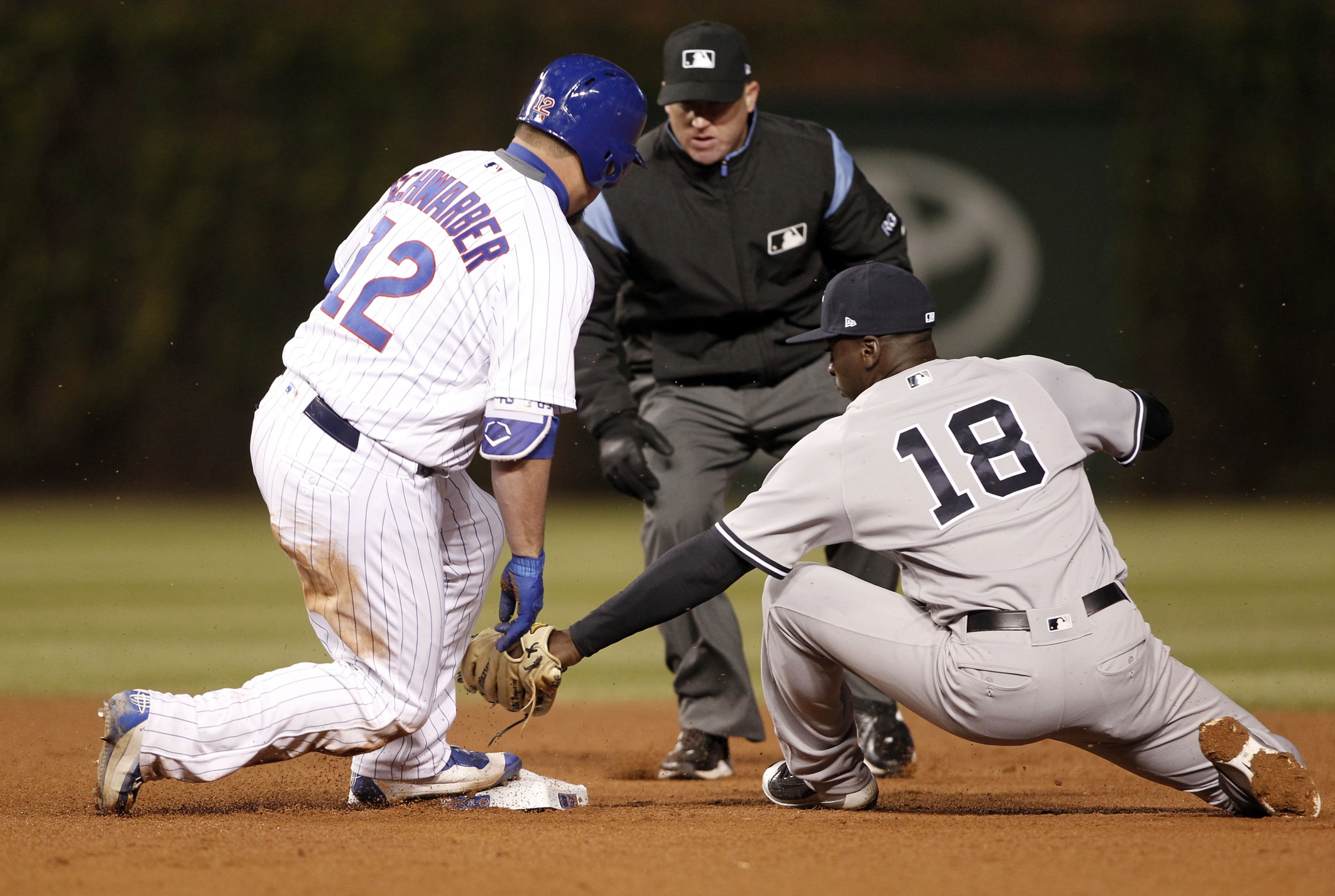Surgically reconstructed knee and all, Kyle Schwarber can still do a lot of things really well. His hitting in 2017 is not yet cause for celebration, and while at times his defense in left field can dazzle us, at others we might be forgiven for wanting to look away.
There is one aspect of Schwarber’s game that stands mostly unassailable thus far, however, and it is his baserunning.
Now, we could all be forgiven for looking at the six foot, 235 pound Indiana University product and thinking not only that he found the Hoosier baseball fields en route to linebacker drills and just never left, but also that, as a baseball player, he should be expected to do little more than lumber around the basepaths and just try not to get in the way. But in reality, he is actually, well, sort of good at it.
No, he should not be extolled for the poetic grace of his striding from first to third, but if we take a look at some of Baseball Prospectus’ measures for evaluating a player’s prowess in this regard, we will find that the Schwarbs rates out nicely.
| BRR | HAR | GAR | OAR | SBR | AAR | |
| 2015 | 3.4 | 2.87 | 0.48 | -0.01 | -0.14 | 0.21 |
| 2017 | 1.0 | 0.37 | 0.61 | -0.01 | 0.00 | 0.01 |
Without context, it’s hard to know what to make of these numbers, but in almost each metric, Schwarber sits above average, and according to Baserunning Runs (BRR) he was verging on great in 2015. Even his 1.0 thus far in 2017 is a full point above average. I have left out his 2016 numbers, obviously, because the sample size is so tiny that they are not at all useful. And yes, his 2017 totals are far off from what he did in 2015, so it should be remembered that right now, Schwarber is about 100 plate appearances shy of the number he had in 2015, and it’s also worth noting that he is reaching base far less often this season, so his opportunity to amass some of these numbers has been greatly reduced.
But let’s boil this down a little. BRR is the general measure, incorporating each of the sub-measures included above. What it means is that every player is measured based on his advancement on the bases in each type of situation that presents that possibility. By BRR then, Dee Gordon is the best runner in the league right now (4.6), and Dustin Pedroia is the worst (-3.2). Among his teammates, Schwarber is behind only Kris Bryant (1.6) and Albert Almora, Jr. (1.2).
A dive into the pieces that make up the whole that is BRR shows where he does well, and where his weaknesses are. HAR (Hit advancement runs) measures advancement from first on singles, second on singles, and from first on doubles. This was one of the things raised as a concern when Joe Maddon first hinted that he would be batting in the first spot—that he might struggle to move station to station and hinder the runner behind him. This year, he is nowhere near his 2015 total, but he has also not exactly stunk at it, either. At 0.37, he is just slightly above average. Not great, but far from problematic.
The part referred to as GAR (Ground advancement runs) measures a series of scenarios, and here I’ll borrow directly from the Baseball Prospectus glossary:
- Runner on first only with less than two outs, ground ball or bunt is hit to an infielder where a hit or an error is not credited
- Runner on second only with less than two outs, ground ball or bunt is hit to an infielder where a hit or an error is not credited
- Runner on third only with less than two outs, ground ball or bunt is hit to an infielder where a hit or an error is not credited
In this regard, Schwarber is just a touch above average, but he is certainly not a liability. Here, Ben Zobrist (1.53) leads the Cubs, and Addison Russell (-0.67) is the worst batter—Jon Lester is technically the worst on the team at -1.02, but it seemed unfair to name him with guys who reach base with far more regularity—so Schwarber is pretty solidly middle of the pack among his teammates.
The other three parts of the equation—OAR (Other advancement runs), SBR (Stolen base runs), and AAR (Air advancement runs)—are all pretty small factors to the whole, but Schwarber’s OAR actually places him just a bit below average, which means he’s not as likely to advance on a wild pitch or a passed ball. It should surprise no one that he isn’t a base-stealer—he swiped three in 2015, and none since—and he probably never will be, so his numbers there don’t tell us anything, as he has not even attempted a stolen base this season. Finally, his AAR number of 0.01 is negligible, but it does make him solidly average. Like wild pitches and passed balls, Schwarber is just never going to do a lot of tagging up and taking an extra base on a fly ball in the air, unless it is a pretty sure thing.
Right now Schwarber is under-performing even PECOTA’s lowest projections, so it can be pretty safely assumed that he is going to improve at the plate even just a little. But no matter what he does, the Cubs’ left fielder is surprisingly deft on the basepaths, and in a season that has so far been heavy with frustration, that’s worth celebrating.
Lead photo courtesy Caylor Arnold—USA Today Sports

Great stuff. Who’d a thunk it?